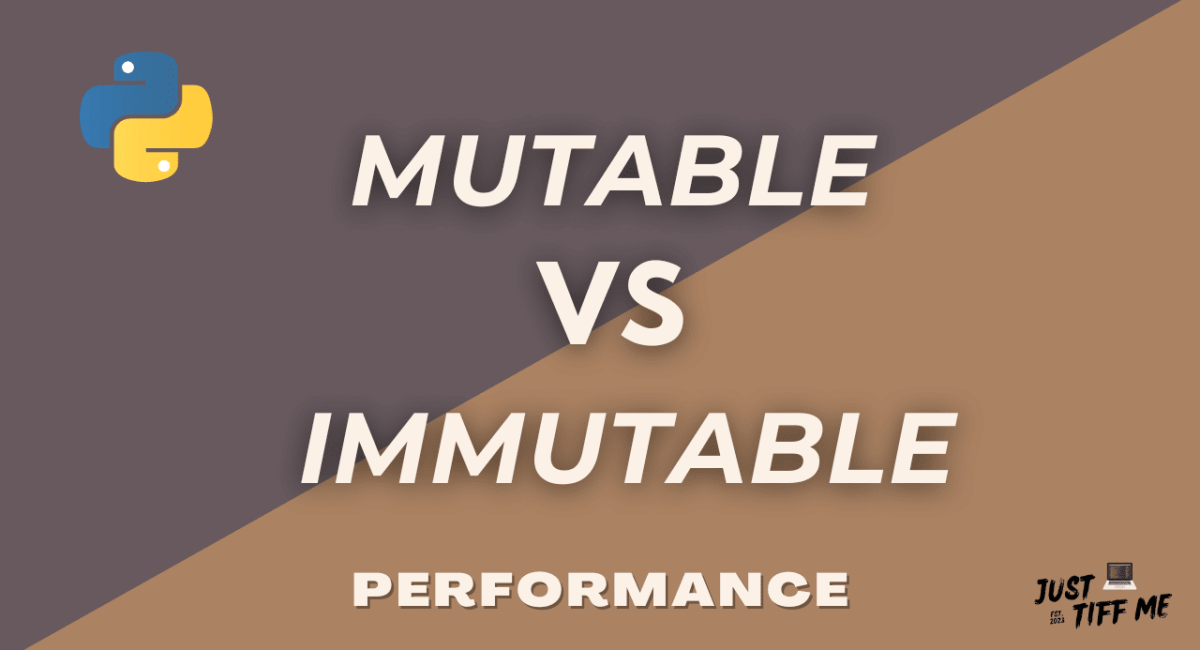In Python, data types can be categorized as either mutable or immutable. Mutable data types are those that can be altered after creation, while immutable data types are ones that remain constant once they are defined.
Understanding this distinction is essential because it directly impacts memory usage, performance, and the behavior of your Python programs.
Understanding Mutable and Immutable Data Types
In Python, data types can be categorized as either mutable or immutable. Mutable data types are those that can be altered after creation, while immutable data types are ones that remain constant once they are defined.
Understanding this distinction is essential because it directly impacts memory usage, performance, and the behavior of your Python programs.
Mutable Data Types: The Transformers
Mutable data types include lists and dictionaries, and sets. These types can be modified by adding, removing, or changing elements.
Imagine a list as a shopping list—you can add, remove, or shuffle items. Dictionaries are like phone books—you can add names, update numbers, or erase contacts.
shopping_list = ["apples", "bananas", "chocolate"]
shopping_list.append("cookies") # Add cookies to the list
# Enchanted dictionary
contacts = {"Alice": "123-456-7890", "Bob": "987-654-3210"}
contacts["Alice"] = "555-555-5555" # Change Alice's number
However, the mutability also introduces complexity and potential side effects, particularly in concurrent programming.
Immutable Data Types
On the other hand, immutable data types are fixed and cannot be changed once created. Strings, numbers (integers and floating-point), and tuples fall into this category.
When you define a string with a specific sequence of characters or a numeric value, it remains the same throughout the program’s execution.
# Your name
name = "Alice"
# 'name' will always be "Alice"
# Your age
age = 16
# Your age stays 16, no magic age-changing here
Immutable objects simplify code by ensuring that their values remain constant. This property enhances code predictability and is particularly useful in multi-threaded environments. Additionally, due to their unchanging nature, immutable objects can be used as keys in dictionaries.
However, the immutability of objects can be limiting in scenarios where frequent modifications are required. For instance, dealing with large datasets using immutable objects can lead to increased memory consumption and slower execution times.
Comparing Memory Usage: Mutable vs. Immutable Example
Let’s consider a scenario involving a list (mutable) and a tuple (immutable) with the same elements. We’ll modify the list and observe how memory usage changes compared to the unmodified tuple.
import sys
# Create a list and a tuple with the same elements
my_list = [1, 2, 3]
my_tuple = (1, 2, 3)
# Print the memory usage of both objects
print("Memory usage of list:", sys.getsizeof(my_list))
print("Memory usage of tuple:", sys.getsizeof(my_tuple))
# Modify the list
my_list.append(4)
# Print the memory usage of both objects after modification
print("Memory usage of list after modification:", sys.getsizeof(my_list))
print("Memory usage of tuple after modification:", sys.getsizeof(my_tuple))
Output:
Memory usage of list: 96
Memory usage of tuple: 72
Memory usage of list after modification: 128
Memory usage of tuple after modification: 72
In the example above, you can see that the memory usage of the list increases after the modification. This is because the list needed to allocate more memory to accommodate the additional element. On the other hand, the tuple’s memory usage remains constant because it’s immutable.
Memory Usage of Immutable Data Types
When it comes to immutable data types like strings and numbers, Python is super clever. It stores them in a way that’s efficient and neat.
Instead of creating multiple copies of the same data, Python just points to the same place in memory.
Memory Efficiency Through Immutability
Here’s the magic: since these data types can’t change, Python doesn’t need to allocate extra memory for future changes. When you create a string or a number, it stays put.
No need to worry about resizing or reshuffling things around. This makes your program run faster and saves precious memory space.
name1 = "Alice"
name2 = "Alice"
print(id(name1)) # Prints the memory location of 'name1'
print(id(name2)) # Prints the memory location of 'name2'
Surprise! When you run this code, you’ll see that `name1` and `name2` share the same memory location. Python is smartly reusing the memory for the same string. name1 and name2 are pointing to the same location.
This memory-saving technique is possible due to the immutability of strings. Since strings cannot be modified after creation, Python can safely reuse the same memory location for identical string values, optimizing memory usage.
Memory Inefficient
Immutable objects consume more memory, as each modification requires a new object to be created. This can lead to memory fragmentation and potentially slower execution in memory-intensive applications.
Memory Management for Mutable Data Types
Mutable data types like lists and dictionaries offer the flexibility to change their contents. However, this flexibility comes with a memory price tag. When you modify a mutable object, Python needs to allocate extra memory to accommodate the changes. This can lead to memory fragmentation over time.
Imagine you have a list of friends’ names. If you add more names than the list can currently hold, Python might need to find a bigger chunk of memory to fit them all. This process involves copying the existing data to the new memory spot and updating all the references.
It’s like moving your furniture to a larger room — some effort, but worth it for more space.
In-Place Modifications and Memory Overhead
Sometimes, you might want to modify a mutable object without creating a new one from scratch. This is called an “in-place modification.”
While this can be memory-efficient, keep in mind that in-place changes can still lead to memory overhead due to object copying and resizing.
Let’s dive into some code to see these concepts in action:
friends = ["Alice", "Bob", "Charlie"]
print(id(friends)) # Prints the memory location of the list
friends.append("David") # Adding a new friend
print(id(friends)) # Memory location might change after modification
In this example, the memory location of the `friends` list might change after the new name is added. This indicates that memory was allocated or rearranged to accommodate the extra name.
Performance Considerations: Immutability vs. Mutability
Let’s dive into the performance aspects of immutability and mutability in Python’s data types.
Immutable Objects and Performance
Immutable data types resemble consistent runners maintaining a steady pace throughout a race. They don’t change, offering predictability and stability.
Considering performance, immutable types excel when you need reliability. They provide a smooth ride, akin to cruising on a well-maintained road.
However, what if you want to modify the object?
The thing is, every time you modify an immutable object, Python creates a whole new object with the updated value. This can use up more memory and make your program slower because you’re generating a bunch of new objects. Think of it like writing a new book every time you want to change a single word—it’s a bit wasteful.
Mutable Objects and Performance
Mutable, although versatile, can introduce complexities that hamper speed. Altering a mutable object often involves reallocating memory and copying, leading to performance hits, especially with hefty data sets.
They are like runners who adjust their gear while running. They’re adaptable, yet these adjustments might slow them down a tad.
Mutable objects, on the bright side, can be changed directly without creating new objects. This can be really handy when you’re making a lot of changes, like adding or removing items from a list.
Mutable objects, such as lists or dictionaries, are like your reusable notebook where you can scribble and erase without getting a new one every time.
Since mutable objects allow you to make changes in place, they generally use up less memory and can make your program run faster in scenarios where you’re doing a lot of modifications.
Performance Improvements with Immutable Data Types
When you use an immutable object, you’re essentially telling Python, “Hey, this won’t change, so optimize it!”
Python can make smart choices in the background to improve memory usage and speed. It’s like giving your program a boost by eliminating unnecessary memory shuffling.
# Using an immutable tuple
point = (5, 10)
x, y = point # No memory overhead for unpacking
# Using a mutable list
coordinates = [5, 10]
x, y = coordinates # Memory overhead for unpacking a list
In this example, using an immutable tuple has a performance advantage during unpacking because Python knows the values won’t change. With a mutable list, there’s a bit more overhead due to potential changes.
So, while mutable have their own charm, immutables can be your go-to choice for smoother performance in certain situations. It’s all about choosing the right tool for the job!
Mutability and Side Effects: The Domino Effect
When you modify a mutable object, it doesn’t just change within its own scope—it can affect other scopes or parts of your code that use the same object.
This can lead to bugs that are hard to track down. It’s like knocking over one domino and watching the rest fall, creating chaos.
def double_numbers(numbers):
for i in range(len(numbers)):
numbers[i] *= 2
my_list = [1, 2, 3, 4]
double_numbers(my_list)
print(my_list) # Oops! The original list is changed as well
In this example, the function `double_numbers` modifies the list it’s given. But guess what? The original list outside the function also changes! This is a classic side effect—the modification affected a broader scope than intended.
Debugging Challenges
When you have side effects lurking around, debugging becomes a puzzle hunt. You might see unexpected behavior in one part of your program due to changes made elsewhere.
Tracking down the culprit can be like finding a needle in a haystack. But don’t worry—Python provides tools and techniques to minimize side effects and keep your code sane.
So, while mutable data types are powerful tools, remember that with great power comes great responsibility. Be cautious, plan your changes wisely, and keep an eye out for those tricky side effects that can turn your program into a puzzling adventure.
Balancing Memory and Performance
When it comes to choosing data types, it’s not just about the task—it’s also about striking a balance between memory and performance.
Immutable data types like **tuples** are memory-efficient and provide better performance for certain operations. On the other hand, mutable data types like **lists** offer flexibility but might come with a bit more memory overhead.
Consider the memory usage and performance needs of your task. If you’re working with a large dataset where changes are infrequent, immutables might be a better choice. But if you need to frequently modify and manipulate data, mutable could be your go-to.
When to Choose Immutability
- In multithreaded environments to avoid race conditions.
- For stable, unchanging data structures.
- When predictability in memory usage is paramount.
When to Choose Mutability
- For efficient data updates and modifications.
- In scenarios with dynamic state changes.
- When memory efficiency is crucial.
Making the Right Call: Example
Let’s say you’re building a simple to-do list app. You want to store tasks along with their due dates. Each task can have a description and a date associated with it.
Here’s how you might choose the right data type for the job:
# Storing tasks using a list of dictionaries
tasks = [
{"description": "Buy groceries", "due_date": "2023-09-01"},
{"description": "Finish report", "due_date": "2023-08-30"},
{"description": "Exercise", "due_date": "2023-08-31"}
]
In this example, using a **list** to store dictionaries provides a neat way to organize the tasks and their associated details.
Remember, choosing the right data type is like picking the right tool for the job. Understand your task’s requirements, consider memory and performance, and you’ll be on the path to writing efficient and effective code!
Conclusion
Understanding the distinction between mutable and immutable objects is essential for writing efficient and reliable Python code.
Immutable objects offer predictability, thread safety, and hashability advantages, but they might not be the best choice for scenarios requiring frequent modifications due to potential performance issues.
Careful consideration of the nature of your data and the requirements of your application will guide your decision on whether to use mutable or immutable objects.
FAQs
Common examples include integers, floats, strings, and tuples.
Mutable objects are useful when frequent changes to data are required, such as in dynamic data structures.
Immutable objects tend to consume more memory due to the creation of new objects with each modification.
Yes, using a hybrid approach can provide a balanced solution that suits various parts of your application.
Utilizing immutable data structures and employing in-place modifications for mutable objects can enhance performance.




